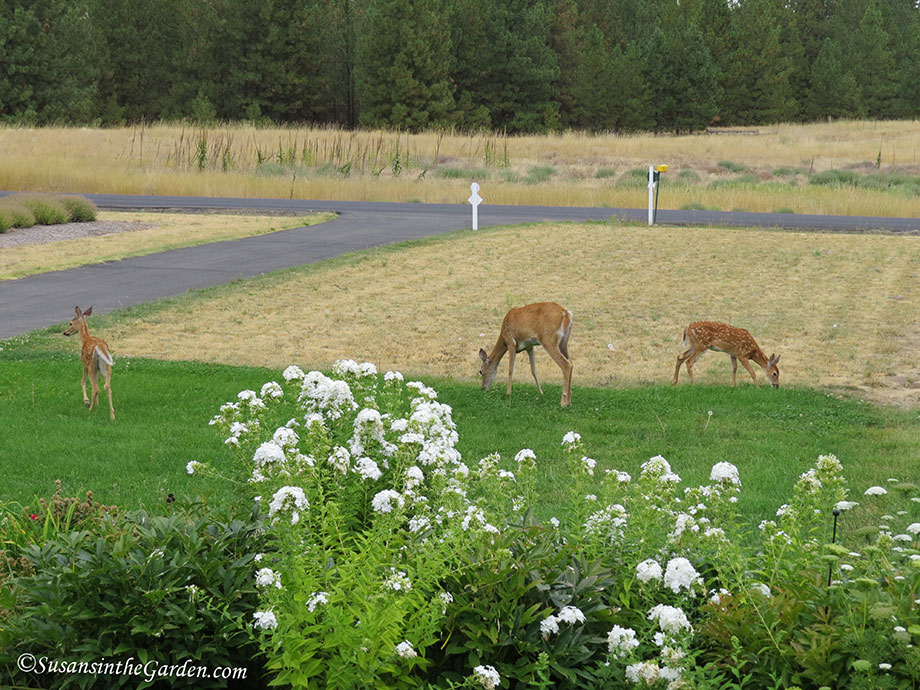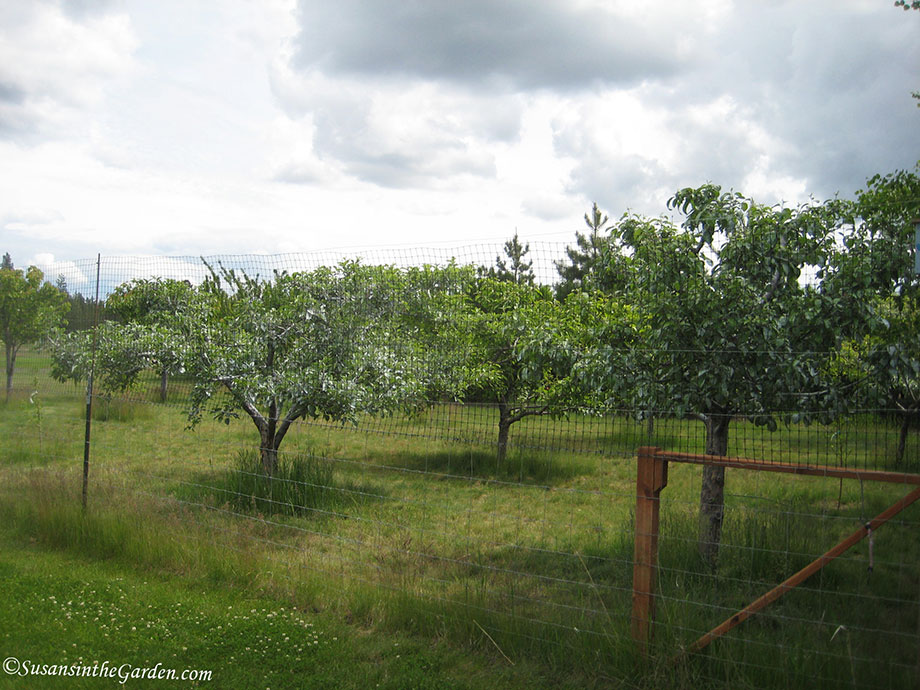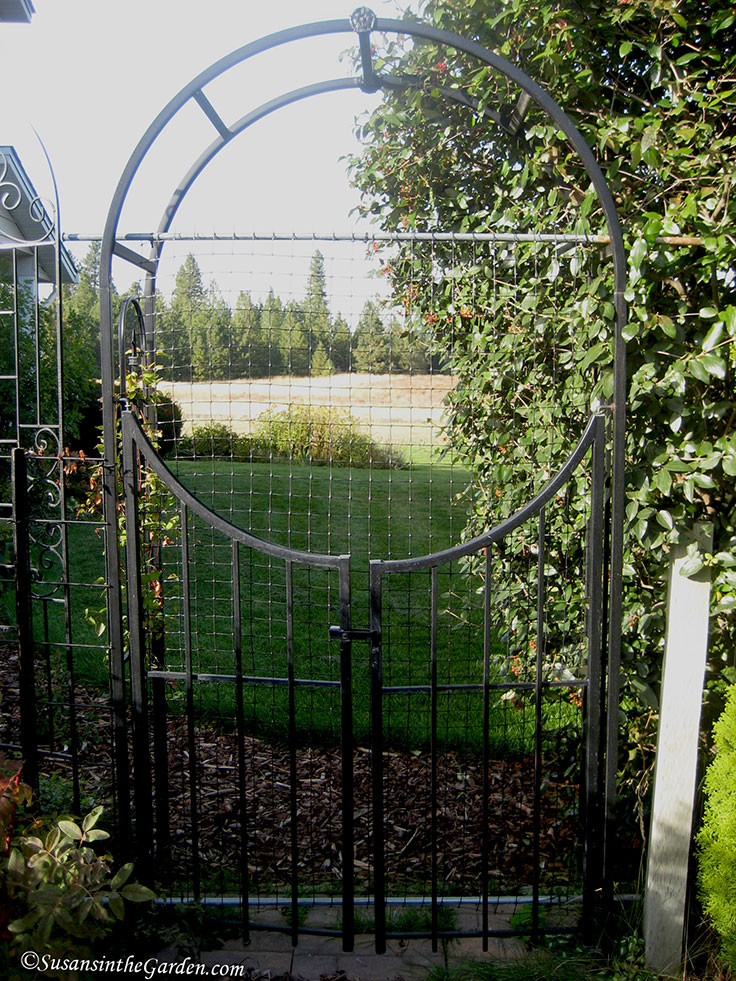June 27 Column: Deer in the Garden

Deer are one of the most challenging critters to deal with in the garden. Unfortunately, I know this from personal experience. I’ve learned some tips and tricks over the years that I wanted to share the information in this week’s column. You can read it in today’s edition of The Spokesman-Review: Dealing with deer. (or you can read the text of my column at the bottom of this post)
There are a few different types of strategies that are effective: repelling deer, scaring them and/or erecting barriers to keep them away. In my column, I give examples of each.
There are two books that I recommend on this subject: Deerproofing Your Yard & Garden by Rhonda Massingham Hart and Deer-Resistant Design by Karen Chapman. I reviewed Karen’s book in Nov. 2019; here’s a link to it in case you’d like to know more. (note: I’ve linked to both of these books on Amazon for your convenience; I do have an Amazon associates account but this does not affect the price you pay)
In addition to dealing with deer, we’ve also gotten the occasional moose, porcupines, raccoons, pocket gophers and voles. We rarely have problems with squirrels, thank goodness, but I think we certainly get enough of the other types of pests!
In my column, I mentioned our deer fence. It surrounds our small orchard, the vegetable garden and the landscape portion of our back yard. I thought I would include a photo of it along with some additional information, just in case you’re curious about it.
We live in a rural area with wide open spaces. Because of this, we did not want to go with a solid fence which would have broken up our views. Fencing can be so expensive, too. We already had a 4′ tall wire field fence surrounding those areas to keep our dogs in. Bill had a great idea: he pounded in tall rods of rebar at the metal fenceposts. Then he secured another 3 1/2′ of heavy-duty deer netting to create a 7 1/2′ tall deer fence. It works GREAT!
We also block the openings in our “moon” gates during the fall and winter months when deer tend to be bolder about jumping over gates. It also is very effective.
It’s made with two 4′-long sticks of EMT (electrical metal tubing) and a rectangle of the plastic deer netting, which is attached to the EMT with zip-ties. Easy-peasy! (you can click on this photo as well to view a larger image)
What about this week’s video? I knew it was time for another virtual tour of our vegetable garden so that’s the topic for this week’s video. I hope you’ll enjoy seeing how the garden is coming along:
And here is my column on dealing with deer:
By Susan Mulvihill
For The Spokesman-Review
I get a lot of questions from gardeners about how to deal with deer. These four-legged pests can present us with huge challenges because they cause a lot of damage and they can be unpredictable.
I’m going to cut right to the chase: the most effective way to keep deer out of our gardens is through the use of barriers. Fences that are at least 7 feet tall work particularly well.
Since my husband and I live in a rural area, we wanted to avoid the use of solid fencing that would break up our view of the surrounding countryside. We mainly wanted to keep deer out of our small orchard and immediate backyard where our vegetable garden and most of our flower beds are located. Our 7-and-a-half-foot-tall wire deer fence is very effective and relatively hard to see, except when it’s encased in hoar frost or snow during the winter.
If you’re not crazy about the idea of such a tall fence, consider two sets of lower fences spaced about 4 feet apart. There are many designs for this type of fencing but the concept behind it is that deer are scared to jump high and wide at the same time.
I realize that fencing a yard isn’t always an option so let’s look at some other ways to keep the deer from munching on your edible and ornamental plants.
Deer have a keen sense of smell. Take advantage of that by using repellents. You can make your own by beating a dozen eggs, adding them to a gallon of water in a clean sprayer and applying the mixture to the plants deer find most appealing. If it rains, you will need to reapply it.
Try hanging bars of deodorant soap from tree branches, stakes or fence posts at a deer’s nose level. Even though we humans think we smell great after using them in the shower, the fact is that deer find the fragrance offensive. I don’t mind offending them one bit. If you do hang soap from tree branches, use a loose, stretchy material that won’t cut into the bark and damage the tree.
Garden centers and online sources carry a wide variety of commercial repellents. If you’re trying to keep deer away from edible plants, be sure to choose a product that is specifically labeled for this and follow the directions to the letter.
Deer are creatures of habit. Oftentimes, they’ll take the same path to a particular area of your landscape. There are adjustable, motion-activated sprinklers that will shoot a strong spray of water when something walks into range. A word to the wise: don’t forget about it once you’ve set the sprinkler because it might blast you instead of a deer.
Some folks string monofilament fishing line between trees or across paths that deer frequent. Since they mainly visit gardens at night, deer rarely see them so they are startled when they walk into the lines.
In the early days of creating our landscape, we unknowingly planted some deer favorites such as arbor vitae, tulips, hostas and roses. I’ve since learned that if I want to enjoy tulips, I must plant them in our backyard, behind the deer fence.
Even when you apply different strategies to keep them away, be aware that drought conditions make deer bolder because they know our landscapes are filled with well-watered plants. Since we are having a particularly dry year, they might visit your yard more often than usual.
The one thing I’ve learned – and have heard repeatedly from frustrated gardeners – is that not all methods work at keeping deer out of our landscapes. What works in one garden might not work in another. Additionally, deer don’t always know they’re not supposed to like so-called deer-resistant plants. Because of this, you need to be resourceful and flexible. Experiment a bit, ask others what they’ve had success with and see if you can gain the upper hand.Susan Mulvihill is author of “The Vegetable Garden Pest Handbook.” She can be reached at Susan@susansinthegarden.com. Watch this week’s “Everyone Can Grow a Garden” video at youtube.com/susansinthegarden.



